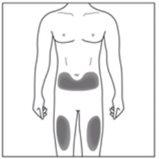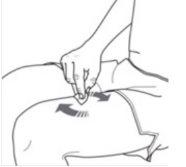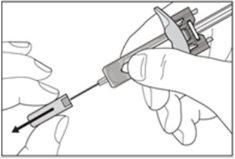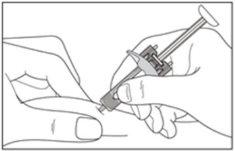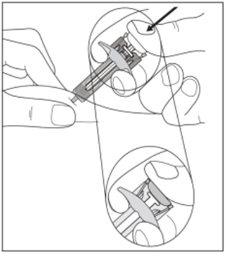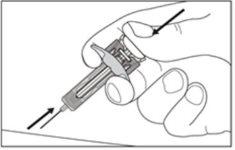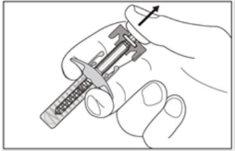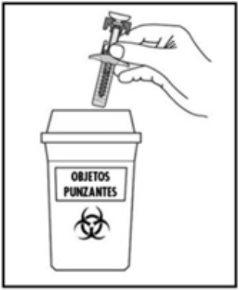
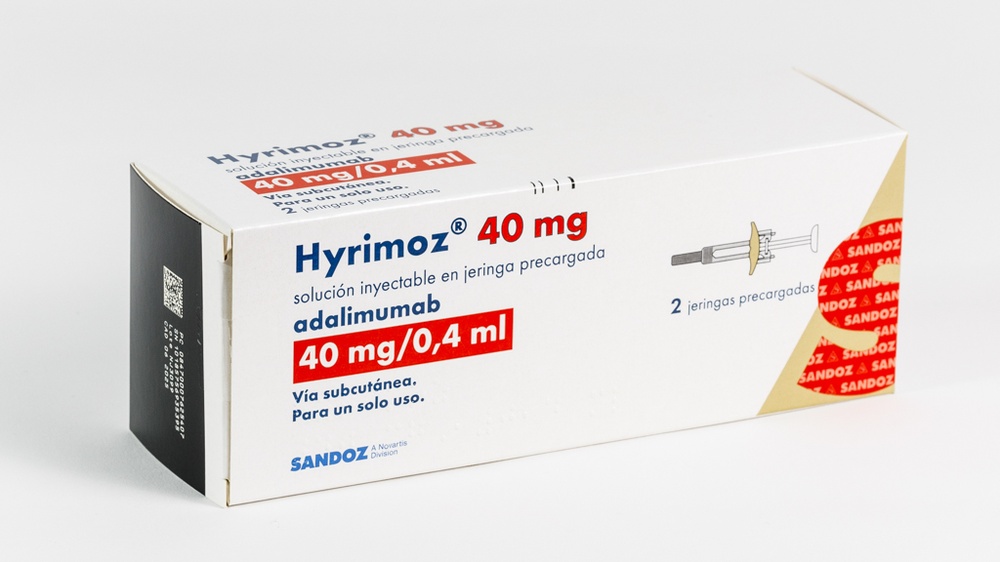
ХИРИМОЗ 40 мг РОЗЧИН ДЛЯ ІН'ЄКЦІЙ У ПЕРЕДНАПОВНЕНИХ ШПРИЦАХ


Інструкція із застосування ХИРИМОЗ 40 мг РОЗЧИН ДЛЯ ІН'ЄКЦІЙ У ПЕРЕДНАПОВНЕНИХ ШПРИЦАХ
Вступ
Опис: інформація для пацієнта
Hyrimoz 40 мг розчин для ін'єкцій у попередньо наповненому шприці
адалімумаб
40 мг/0,4 мл
Прочитайте уважно весь опис перед тим, як почати використовувати цей лікарський засіб, оскільки він містить важливу інформацію для вас.
- Збережіть цей опис, оскільки вам може знадобитися знову його прочитати.
- Ваш лікар надасть вам картку інформації для пацієнта, яка містить важливу інформацію про безпеку, яку вам потрібно знати перед та під час лікування Hyrimoz.
- Збережіть цю картку інформації для пацієнтапротягом усього лікування та протягом 4 місяців після останньої ін'єкції (або ін'єкції вашої дитини) Hyrimoz.
- Якщо у вас виникнуть питання, проконсультуйтеся з вашим лікарем або фармацевтом.
- Цей лікарський засіб призначений лише вам, і не слід давати його іншим людям, навіть якщо вони мають相同ні симптоми, оскільки це може їм нашкодити.
- Якщо ви відчуваєте побічні ефекти, проконсультуйтеся з вашим лікарем або фармацевтом, навіть якщо це побічні ефекти, які не перелічені в цьому описі. Див. розділ 4.
Зміст опису
- Що таке Hyrimoz і для чого він використовується
- Що потрібно знати перед тим, як почати використовувати Hyrimoz
- Як використовувати Hyrimoz
- Можливі побічні ефекти
- Збереження Hyrimoz
- Зміст упаковки та додаткова інформація
- Інструкції з використання
1. Що таке Hyrimoz і для чого він використовується
Hyrimoz містить активну речовину адалімумаб, лікарський засіб, який діє на імунну систему (систему захисту) вашого організму.
Hyrimoz призначений для лікування запальних захворювань, перелічених нижче:
- ревматоїдний артрит,
- ювенільний ідіопатичний поліартрит,
- артрит, пов'язаний з ентезитом,
- анкілозуючий спондиліт
- аксіальний спондилоартрит без радіографічних ознак анкілозуючого спондиліту,
- псоріатичний артрит,
- псоріаз пластинчастий,
- гідраденіт супуративний,
- хвороба Крона,
- виразкова коліт,
- неінфекційний увеїт.
Активна речовина Hyrimoz, адалімумаб, є моноклональним антитілом. Моноклональні антитіла - це білки, які атакують певну ціль в організмі.
Ціль адалімумабу - це інша білкова речовина, звана фактором некрозу пухлини (TNFα), яка знаходиться у високих концентраціях у запальних захворюваннях, перелічених вище. Зв'язуючись з TNFα, Hyrimoz блокує його дію та зменшує запалення у цих захворюваннях.
Ревматоїдний артрит
Ревматоїдний артрит - це запальне захворювання суглобів.
Hyrimoz використовується для лікування ревматоїдного артриту у дорослих. Якщо у вас активний ревматоїдний артрит середньої чи високої активності, вам можуть призначити спочатку інші лікарські засоби, які модифікують захворювання, такі як метотрексат. Якщо ці лікарські засоби не діють достатньо добре, вам буде призначено Hyrimoz для лікування ревматоїдного артриту.
Hyrimoz також може використовуватися для лікування важкого, активного та прогресуючого ревматоїдного артриту без попереднього лікування метотрексатом.
Hyrimoz може зменшити пошкодження суглобів та кісток, викликане захворюванням, та покращити фізичні можливості.
Зазвичай Hyrimoz використовується разом з метотрексатом. Якщо ваш лікар вважає, що метотрексат не підходить, Hyrimoz може бути призначено самостійно.
Ювенільний ідіопатичний поліартрит
Ювенільний ідіопатичний поліартрит - це запальне захворювання суглобів.
Hyrimoz використовується для лікування ювенільного ідіопатичного поліартриту у дітей та підлітків віком від 2 до 17 років. Пацієнти можуть спочатку отримувати інші лікарські засоби, які модифікують захворювання, такі як метотрексат. Якщо ці лікарські засоби не діють достатньо добре, пацієнти отримують Hyrimoz.
Артрит, пов'язаний з ентезитом
Артрит, пов'язаний з ентезитом, - це запальне захворювання суглобів та місць прикріплення сухожилків до кісток. Hyrimoz використовується для лікування артриту, пов'язаного з ентезитом, у пацієнтів віком від 6 років.
Пацієнти можуть спочатку отримувати інші лікарські засоби, які модифікують захворювання, такі як метотрексат. Якщо ці лікарські засоби не діють достатньо добре, цим пацієнтам буде призначено Hyrimoz.
Анкілозуючий спондиліт та аксіальний спондилоартрит без радіографічних ознак анкілозуючого спондиліту
Анкілозуючий спондиліт та аксіальний спондилоартрит без радіографічних ознак анкілозуючого спондиліту - це запальні захворювання, які впливають на хребет.
Hyrimoz використовується для лікування цих захворювань у дорослих. Якщо у вас анкілозуючий спондиліт або аксіальний спондилоартрит без радіографічних ознак анкілозуючого спондиліту, вам спочатку будуть призначені інші лікарські засоби. Якщо ці лікарські засоби не діють достатньо добре, вам буде призначено Hyrimoz для зменшення симптомів та ознак захворювання.
Псоріаз пластинчастий у дорослих та дітей
Псоріаз пластинчастий - це запальне захворювання шкіри, яке викликає червоні, лускаті, з коростами та покриті сріблястими лусками ділянки. Псоріаз пластинчастий також може вплинути на нігті, викликаючи їх пошкодження, загострення та відшарування від нігтьового ложа, що може бути болісним. Гадають, що псоріаз викликаний дефектом імунної системи організму, який призводить до збільшення виробництва клітин шкіри.
Hyrimoz використовується для лікування псоріазу пластинчастого середньої чи високої активності у дорослих. Hyrimoz також використовується для лікування важкого псоріазу пластинчастого у дітей та підлітків віком від 4 до 17 років, які не реагують на лікарські засоби, які наносяться на шкіру, або на лікування ультрафіолетовим світлом.
Псоріатичний артрит
Псоріатичний артрит - це запальне захворювання суглобів, пов'язане з псоріазом.
Hyrimoz використовується для лікування псоріатичного артриту у дорослих. Hyrimoz може зменшити пошкодження суглобів, викликане захворюванням, та покращити фізичні можливості.
Гідраденіт супуративний у дорослих та підлітків
Гідраденіт супуративний (іноді називається інверсійним акне) - це довготривале та часто болісне запальне захворювання шкіри. Симптоми можуть включати чутливі вузли (шишки) та абсцеси (фурункули), які можуть виділяти гній.
Зазвичай це захворювання впливає на певні ділянки шкіри, такі як під грудиною, в пахвових западинах, внутрішній частині стегон, паху та сідницях. Також можуть бути шрами на уражених ділянках.
Hyrimoz використовується для лікування
- гідраденіту супуративного середньої чи високої активності у дорослих та
- гідраденіту супуративного середньої чи високої активності у підлітків віком від 12 до 17 років.
Hyrimoz може зменшити кількість вузлів та абсцесів, а також біль, який зазвичай супроводжує це захворювання. Ви можете спочатку отримувати інші лікарські засоби. Якщо ці лікарські засоби не діють достатньо добре, вам буде призначено Hyrimoz.
Хвороба Крона у дорослих та дітей
Хвороба Крона - це запальне захворювання травного тракту.
Hyrimoz використовується для лікування
- хвороби Крона середньої чи високої активності у дорослих та
- хвороби Крона середньої чи високої активності у дітей та підлітків віком від 6 до 17 років.
Якщо у вас хвороба Крона, вам спочатку будуть призначені інші лікарські засоби. Якщо ці лікарські засоби не діють достатньо добре, вам буде призначено Hyrimoz для зменшення симптомів та ознак хвороби Крона.
Виразкова коліт у дорослих та дітей
Виразкова коліт - це запальне захворювання товстої кишки.
Hyrimoz використовується для лікування
- виразкової коліту середньої чи високої активності у дорослих та
- виразкової коліту середньої чи високої активності у дітей та підлітків віком від 6 до 17 років.
Якщо у вас виразкова коліт, вам можуть спочатку призначити інші лікарські засоби. Якщо ці лікарські засоби не діють достатньо добре, вам буде призначено Hyrimoz для зменшення симптомів та ознак виразкової коліту.
Неінфекційний увеїт у дорослих та дітей
Неінфекційний увеїт - це запальне захворювання, яке впливає на певні частини ока. Запалення викликає зниження зору та/або появу мух у оці (чорних точок або тонких ліній, які рухаються уздовж поля зору). Hyrimoz діє, зменшуючи це запалення.
Hyrimoz використовується для лікування
- дорослих з неінфекційним увеїтом з запаленням, яке впливає на задню частину ока,
- дітей віком від 2 років з хронічним неінфекційним увеїтом з запаленням, яке впливає на передню частину ока.
Ви можете спочатку отримувати інші лікарські засоби. Якщо ці лікарські засоби не діють достатньо добре, вам буде призначено Hyrimoz.
2. Що потрібно знати перед тим, як ваша дитина почне використовувати Hyrimoz
Не використовуйте Hyrimoz
- Якщо ви алергічні на адалімумаб або на будь-який інший компонент цього лікарського засобу (перелічені в розділі 6).
- Якщо ви маєте серйозну інфекцію, включаючи туберкульоз, сепсис (отруєння крові) або інші опортуністичні інфекції (не звичайні інфекції, пов'язані з ослабленням імунної системи). Якщо у вас є симптоми будь-якої інфекції, наприклад: гарячка, рани, втома, проблеми з зубами, важливо повідомити про це вашому лікарю (див. «Попередження та застереження»).
- Якщо ви маєте помірну або серйозну серцеву недостатність. важливо повідомити вашому лікарю, якщо ви мали або маєте серйозні проблеми з серцем (див. «Попередження та застереження»).
Попередження та застереження
Порадьтеся з вашим лікарем або фармацевтом перед тим, як почати використовувати Hyrimoz.
Алергічна реакція
- Якщо у вас виникла алергічна реакція з симптомами, такими як стиск у грудній клітці, труднощі з диханням, головокружіння, набряк або висип, припиніть введення Hyrimoz і негайно зверніться до вашого лікаря, оскільки в рідких випадках ці реакції можуть загрожувати життю.
Інфекції
- Якщо у вас є будь-яка інфекція, включаючи хронічні або локалізовані (наприклад, виразка на нозі), порадьтеся з вашим лікарем перед тим, як почати лікування Hyrimoz. Якщо ви не впевnenі, зверніться до вашого лікаря.
- Під час лікування Hyrimoz ви можете легше заразитися інфекціями. Це ризик може бути більшим, якщо знижується активність ваших легень. Ці інфекції можуть бути серйозними і включати туберкульоз, інфекції, викликані вірусами, грибами, паразитами або бактеріями, або іншими інфекційними агентами, а також сепсис (отруєння крові).
- У рідких випадках ці інфекції можуть загрожувати життю. важливо повідомити вашому лікарю, якщо у вас є симптоми, такі як гарячка, рани, втома або проблеми з зубами. Ваш лікар може порекоменувати тимчасово припинити лікування Hyrimoz.
Туберкульоз (ТБ)
- Оскільки були описані випадки туберкульозу у пацієнтів, які приймали адалімумаб, ваш лікар огляне вас на предмет ознак або симптомів туберкульозу перед тим, як почати лікування Hyrimoz. Це включатиме проведення ретельного медичного огляду, включаючи вашу медичну історію та діагностичні тести (наприклад, рентген легень і проба на туберкульоз). Результати цих тестів повинні бути записані у вашій картці інформації для пацієнта. важливо повідомити вашому лікарю, якщо ви мали туберкульоз або були в контакті з пацієнтом, який мав туберкульоз. Туберкульоз може розвинутися під час лікування, навіть якщо ви приймали профілактичне лікування проти туберкульозу. Якщо у вас з'являються симптоми туберкульозу (тривала кашель, втрата ваги, відсутність енергії, субфебрильна температура) або будь-якої іншої інфекції під час або після лікування, негайно зверніться до вашого лікаря.
Подорожі/рецидив інфекції
- Повідоміть вашому лікарю, якщо ви проживали або подорожували країнами, де інфекції, такі як гістоплазмоз, кокцидіомікоз або бластомікоз, є поширеними.
- Повідоміть вашому лікарю, якщо у вас є історія рецидивних інфекцій або інших патологій, які збільшують ризик інфекцій.
Вірус гепатиту Б
- Повідоміть вашому лікарю, якщо ви є носієм вірусу гепатиту Б (ВГБ), якщо у вас є активна інфекція ВГБ або якщо ви думаєте, що можете бути під загрозою інфекції ВГБ. Ваш лікар повинен провести аналіз на ВГБ. Адалімумаб може реактивувати ВГБ у осіб, які є носіями цього вірусу. У рідких випадках, особливо якщо ви приймаєте інші лікарські засоби, які пригнічують імунну систему, реактивація інфекції ВГБ може загрожувати життю.
Вік понад 65 років
- Якщо вам понад 65 років, ви можете бути більш схильними до інфекцій під час лікування Hyrimoz. Ви та ваш лікар повинні звернути особливу увагу на появу ознак інфекції під час лікування Hyrimoz. важливо повідомити вашому лікарю, якщо у вас є симптоми інфекції, такі як гарячка, рани, втома або проблеми з зубами.
Стоматологічні процедури або операції
- Якщо вам мають бути проведені хірургічні або стоматологічні процедури, повідоміть вашому лікарю, що ви приймаєте Hyrimoz. Ваш лікар може порекоменувати тимчасово припинити лікування Hyrimoz.
Демієлінізуючі захворювання
- Якщо у вас є або розвивається демієлінізуюче захворювання (захворювання, яке впливає на ізоляційний шар, який оточує нерви, наприклад, множинний склероз), ваш лікар вирішить, чи слід вам продовжувати лікування Hyrimoz. Повідоміть негайно вашому лікарю, якщо у вас є симптоми, такі як зміни в зорі, слабкість у руках або ногах або оніміння або поколювання в будь-якій частині тіла.
Вакцинація
- Деякі вакцини містять живі, але ослаблені форми бактерій або вірусів, які можуть викликати захворювання, і не повинні вводитися під час лікування Hyrimoz, оскільки можуть викликати інфекції. Порадьтеся з вашим лікарем перед введенням будь-якої вакцини. Рекомендується, якщо це можливо, щоб діти отримали всі заплановані вакцини для свого віку перед тим, як почати лікування Hyrimoz. Якщо ви приймаєте Hyrimoz під час вагітності, ваша дитина може мати більший ризик інфекції протягом приблизно 5 місяців після останньої дози Hyrimoz, яку ви прийняли під час вагітності. важливо повідомити лікарю вашої дитини та іншим медичним працівникам про ваше використання Hyrimoz під час вагітності, щоб вони могли вирішити, чи слід вашій дитині отримати будь-яку вакцину.
Серцева недостатність
- важливо повідомити вашому лікарю, якщо у вас були або є серйозні проблеми з серцем. Якщо у вас є легка серцева недостатність і ви приймаєте Hyrimoz, ваш лікар повинен проводити постійний моніторинг вашої серцевої недостатності. Якщо у вас з'являються нові симптоми серцевої недостатності або погіршуються існуючі (наприклад, труднощі з диханням або набряк ніг), ви повинні негайно звернутися до вашого лікаря.
Гарячка, синяки, кровотеча або блідість
- У деяких пацієнтів організм може бути нездатний виробляти достатню кількість певного типу клітин крові, які борються з інфекціями (білі клітини крові) або тих, які сприяють зупинці кровотеч (тромбоцити). Якщо у вас є тривала гарячка, синяки або ви легко кровоточите або дуже бліді, негайно зверніться до вашого лікаря. Ваш лікар може вирішити припинити лікування.
Рак
- У дуже рідких випадках були описані випадки певних типів раку у дітей і дорослих, які приймали адалімумаб або інші засоби, які блокують TNFα. Люди з ревматоїдним артритом більш високого ступеня та тривалого захворювання можуть мати більший ризик розвитку лімфоми та лейкемії (рак, який впливає на клітини крові та кістковий мозок). Якщо ви приймаєте Hyrimoz, ризик розвитку лімфоми, лейкемії та інших типів раку може збільшитися. Був спостережений рідкісний випадок певного типу лімфоми у пацієнтів, які приймали адалімумаб.
Деякі з цих пацієнтів також приймали лікарські засоби азатіоприн або меркаптопурин. Повідоміть вашому лікарю, якщо ви приймаєте азатіоприн або меркаптопурин з Hyrimoz.
- Були описані випадки раку шкіри (не-меланомного типу) у пацієнтів, які приймали адалімумаб. Повідоміть вашому лікарю, якщо під час або після лікування з'являються нові пошкодження шкіри або якщо існуючі пошкодження шкіри змінюють свій вигляд.
- Були описані випадки раку, інших ніж лімфома, у пацієнтів з певним захворюванням легень, відомим як хронічна обструктивна захворювання легень (ХОЗЛ), які приймали інші засоби, які блокують TNFα. Якщо у вас є ХОЗЛ або ви палите багато, ви повинні порадитися з вашим лікарем, чи підходить лікування блокатором TNFα для вас.
Аутоімунні захворювання
- У рідких випадках лікування Hyrimoz може спричинити синдром, подібний до системного червоного вовчака. Зверніться до вашого лікаря, якщо у вас є симптоми, такі як тривала неясна ерупція, гарячка, артралгія або втома.
Діти та підлітки
- Вакцинація: якщо це можливо, ваша дитина повинна бути вакцинована проти всіх необхідних захворювань перед тим, як почати лікування Hyrimoz.
Інші лікарські засоби та Hyrimoz
Повідоміть вашому лікарю або фармацевту, якщо ви приймаєте, нещодавно приймали або можете приймати будь-які інші лікарські засоби.
Hyrimoz можна приймати разом з метотрексатом або певними лікарськими засобами, які модифікують захворювання, такими як сульфасалазин, гідроксихлорохін, лефлуномід та ін'єкційні препарати на основі солей золота, кортикостероїди або лікарські засоби для лікування болю, включаючи нестероїдні протизапальні засоби (НПЗ).
Не слід використовувати Hyrimoz разом з лікарськими засобами, активними речовинами яких є анакінра або абатацепт, через підвищений ризик серйозної інфекції. Не рекомендується комбінувати адалімумаб та інші антагоністи TNFα з анакінрою або абатацептом через можливе підвищення ризику інфекцій, включаючи серйозні інфекції, та інших можливих фармакологічних взаємодій. Якщо у вас є сумніви, порадьтеся з вашим лікарем.
Вагітність та лактація
- Ви повинні розглянути використання відповідних методів контрацепції, щоб уникнути вагітності, та продовжувати їх використання протягом至少 5 місяців після останнього лікування Hyrimoz.
- Якщо ви вагітні, думаєте, що можете бути вагітною або плануєте мати дитину, порадьтеся з вашим лікарем про використання цього лікарського засобу.
- Hyrimoz повинен використовуватися під час вагітності тільки у разі необхідності.
- За даними одного дослідження під час вагітності, не було виявлено підвищеного ризику вроджених дефектів, коли мати приймала адалімумаб під час вагітності, порівняно з матерями з тим самим захворюванням, які не приймали адалімумаб.
- Hyrimoz можна використовувати під час лактації.
- Якщо ви приймаєте Hyrimoz під час вагітності, ваша дитина може мати більший ризик інфекції.
- важливо повідомити лікарю вашої дитини та іншим медичним працівникам про ваше використання Hyrimoz під час вагітності, щоб вони могли вирішити, чи слід вашій дитині отримати будь-яку вакцину (для більшої інформації про вакцини див. розділ «Попередження та застереження»).
Водіння автомобіля та використання машин
Вплив Hyrimoz на здатність водити автомобіль, їздити на велосипеді або використовувати машини є малим. Можуть виникнути відчуття, що кімната обертається (вертіго) та порушення зору після використання Hyrimoz.
Hyrimoz містить натрій
Цей лікарський засіб містить менше 1 ммоль (23 мг) натрію на дозу 0,4 мл; тобто, він практично «не містить натрію».
3. Як використовувати Hyrimoz
Слідкуйте точно інструкціям щодо застосування цього лікарського засобу, вказаним вашим лікарем. У разі сумнівів проконсультуйтеся знову з вашим лікарем.
У наступній таблиці вказані рекомендовані дози Hyrimoz для кожного з його затверджених застосувань. Ваш лікар може призначити іншу дозу Hyrimoz, якщо вам потрібна інша доза.
Ревматоїдний артрит, псоріатичний артрит, анкілозуючий спондиліт або аксіальний спондилоартрит без радіографічних ознак анкілозуючого спондиліту | ||
Вік або маса тіла | Яка кількість і з якою частотою слід приймати? лікарський засіб? | Примітки |
Дорослі | 40 мг кожні 2 тижні як одноразова доза | У разі ревматоїдного артриту лікування метотрексатом триває під час застосування Hyrimoz. Якщо ваш лікар визначає, що метотрексат є невідповідним, Hyrimoz можна застосовувати самостійно. Якщо ви страждаєте на ревматоїдний артрит і не приймаєте метотрексат під час лікування Hyrimoz, ваш лікар може вирішити призначити вам 40 мг Hyrimoz кожну тиждень або 80 мг кожні 2 тижні. |
Ювенільний ідіопатичний поліартрит | ||
Вік або маса тіла | Яка кількість і з якою частотою слід приймати? | Примітки |
Діти, підлітки та дорослі від 2 років із масою тіла 30 кг або більше | 40 мг кожні 2 тижні | Не застосовується |
Діти, підлітки від 2 років із масою тіла від 10 кг до менше 30 кг | 20 мг кожні 2 тижні | Не застосовується |
Артрит, асоційований з ентезитом | ||
Вік або маса тіла | Яка кількість і з якою частотою слід приймати? | Примітки |
Діти, підлітки та дорослі від 6 років із масою тіла 30 кг або більше | 40 мг кожні 2 тижні | Не застосовується |
Діти та підлітки від 6 років із масою тіла від 15 кг до менше 30 кг | 20 мг кожні 2 тижні | Не застосовується |
Псоріаз пластинчастий | ||
Вік або маса тіла | Яка кількість і з якою частотою слід приймати? | Примітки |
Дорослі | Перша доза 80 мг (як дві ін'єкції по 40 мг у один день), потім 40 мг кожні 2 тижні, починаючи через тиждень після першої дози. | Вам слід продовжувати ін'єкції Hyrimoz протягом часу, який вказав ваш лікар. Якщо ця доза не діє достатньо добре, ваш лікар може збільшити дозу до 40 мг на тиждень або 80 мг кожні 2 тижні. |
Псоріаз пластинчастий у дітей | ||
Вік або маса тіла | Яка кількість і з якою частотою слід приймати? | Примітки |
Діти та підлітки від 4 до 17 років із масою тіла 30 кг або більше | Перша доза 40 мг, потім 40 мг через тиждень. Потім звичайна доза становить 40 мг кожні 2 тижні. | Не застосовується |
Діти та підлітки від 4 до 17 років із масою тіла від 15 кг до менше 30 кг | Перша доза 20 мг, потім 20 мг через тиждень. Потім звичайна доза становить 20 мг кожні 2 тижні. | Не застосовується |
Гідраденіт супуративний | ||
Вік або маса тіла | Яка кількість і з якою частотою слід приймати? | Примітки |
Дорослі | Перша доза 160 мг (як чотири ін'єкції по 40 мг у один день або дві ін'єкції по 40 мг на день протягом двох поспіль днів), потім 80 мг (як дві ін'єкції по 40 мг у один день) через два тижні. Потім звичайна доза становить 40 мг на тиждень або 80 мг кожні 2 тижні, залежно від призначення лікаря. | Рекомендується використовувати щоденно антисептичну рідину на уражених ділянках. |
Підлітки від 12 до 17 років із масою тіла 30 кг або більше | Перша доза 80 мг (як дві ін'єкції по 40 мг у один день), потім 40 мг кожні 2 тижні, починаючи через тиждень. | Якщо ця доза не діє достатньо добре, ваш лікар може збільшити дозу до 40 мг на тиждень або 80 мг кожні 2 тижні. Рекомендується використовувати щоденно антисептичну рідину на уражених ділянках. |
Хвороба Крона | ||
Вік або маса тіла | Яка кількість і з якою частотою слід приймати? | Примітки |
Дорослі | Перша доза 80 мг (як дві ін'єкції по 40 мг у один день), потім 40 мг кожні 2 тижні, починаючи через два тижні. Якщо потрібно швидша реакція, ваш лікар може призначити першу дозу 160 мг (як чотири ін'єкції по 40 мг у один день або дві ін'єкції по 40 мг на день протягом двох поспіль днів), потім 80 мг (як дві ін'єкції по 40 мг у один день) через два тижні. Потім звичайна доза становить 40 мг кожні 2 тижні. | Якщо ця доза не діє достатньо добре, ваш лікар може збільшити дозу до 40 мг на тиждень або 80 мг кожні 2 тижні. |
Хвороба Крона у дітей | ||
Вік або маса тіла | Яка кількість і з якою частотою слід приймати? | Примітки |
Діти та підлітки від 6 до 17 років із масою тіла 40 кг або більше | Перша доза 80 мг (як дві ін'єкції по 40 мг у один день), потім 40 мг кожні 2 тижні, починаючи через два тижні. Якщо потрібно швидша реакція, ваш лікар може призначити першу дозу 160 мг (як чотири ін'єкції по 40 мг у один день або дві ін'єкції по 40 мг на день протягом двох поспіль днів), потім 80 мг (як дві ін'єкції по 40 мг у один день) через два тижні. Потім звичайна доза становить 40 мг кожні 2 тижні. | Якщо ця доза не діє достатньо добре, лікар вашої дитини може збільшити дозу до 40 мг на тиждень або 80 мг кожні 2 тижні. |
Діти та підлітки від 6 до 17 років із масою тіла менше 40 кг | Перша доза 40 мг, потім 20 мг кожні 2 тижні, починаючи через два тижні. Якщо потрібно швидша реакція, ваш лікар може призначити першу дозу 80 мг (як дві ін'єкції по 40 мг у один день), потім 40 мг через два тижні. Потім звичайна доза становить 20 мг кожні 2 тижні. | Якщо ця доза не діє достатньо добре, лікар вашої дитини може збільшити частоту дози до 20 мг на тиждень. |
Ульцеративний коліт | ||
Вік або маса тіла | Яка кількість і з якою частотою слід приймати? | Примітки |
Дорослі | Перша доза 160 мг (як чотири ін'єкції по 40 мг у один день або дві ін'єкції по 40 мг на день протягом двох поспіль днів), потім 80 мг (як дві ін'єкції по 40 мг у один день) через два тижні. Потім звичайна доза становить 40 мг кожні 2 тижні. | Якщо ця доза не діє достатньо добре, ваш лікар може збільшити дозу до 40 мг на тиждень або 80 мг кожні 2 тижні. |
Ульцеративний коліт у дітей | ||
Вік або маса тіла | Яка кількість і з якою частотою слід приймати? | Примітки |
Діти та підлітки від 6 років із масою тіла 40 кг або більше | Перша доза 160 мг (як чотири ін'єкції по 40 мг у один день або дві ін'єкції по 40 мг на день протягом двох поспіль днів), потім 80 мг (як дві ін'єкції по 40 мг у один день) через два тижні. Потім звичайна доза становить 80 мг кожні 2 тижні. | Пацієнти, які досягнуть 18 років під час лікування дозою 80 мг кожні 2 тижні, повинні продовжувати приймати призначену дозу. |
Діти та підлітки від 6 років із масою тіла менше 40 кг | Перша доза 80 мг (як дві ін'єкції по 40 мг у один день), потім 40 мг (як одна ін'єкція 40 мг) через два тижні. Потім звичайна доза становить 40 мг кожні 2 тижні. | Пацієнти, які досягнуть 18 років під час лікування дозою 40 мг кожні 2 тижні, повинні продовжувати приймати призначену дозу. |
Неінфекційний увеїт | ||
Вік або маса тіла | Яка кількість і з якою частотою слід приймати? | Примітки |
Дорослі | Перша доза 80 мг (як дві ін'єкції по 40 мг), потім 40 мг кожні 2 тижні, починаючи через тиждень після першої дози. | У разі неінфекційного увеїту можна продовжувати лікування кортикостероїдами або іншими лікарськими засобами, що впливають на імунну систему, під час застосування Hyrimoz. Hyrimoz також можна застосовувати самостійно. Вам слід продовжувати ін'єкції Hyrimoz протягом часу, який вказав ваш лікар. |
Діти та підлітки від 2 років із масою тіла 30 кг або більше | 40 мг кожні 2 тижні | Ваш лікар також може призначити першу дозу 80 мг, яка може бути застосована за тиждень до початку звичайної дози 40 мг кожні 2 тижні. Рекомендується використання Hyrimoz у поєднанні з метотрексатом. |
Діти та підлітки від 2 років із масою тіла менше 30 кг | 20 мг кожні 2 тижні | Ваш лікар також може призначити першу дозу 40 мг, яка може бути застосована за тиждень до початку звичайної дози 20 мг кожні 2 тижні. Рекомендується використання Hyrimoz у поєднанні з метотрексатом. |
Форма і шлях застосування
Hyrimoz вводиться під шкіру (підшкірно).
Детальні інструкції щодо введення Hyrimoz наведені в розділі 7, «Інструкції з застосування».
Якщо ви прийняли більше Hyrimoz, ніж потрібно
Якщо ви випадково ввели Hyrimoz з більшою частотою, ніж потрібно, зверніться до вашого лікаря або фармацевта та поясніть, що ви прийняли більше, ніж потрібно. Зегда носіть з собою упаковку лікарського засобу, навіть якщо вона порожня.
Якщо ви забули прийняти Hyrimoz
Якщо ви забули зробити ін'єкцію, вам слід ввити наступну дозу Hyrimoz як тільки ви про це вспомните. Потім наступна доза буде введена звичайним чином, як якщо б ви не забули про прийняття дози.
Якщо ви припинили лікування Hyrimoz
Рішення про припинення застосування Hyrimoz повинно бути обговорено з вашим лікарем. Ваші симптоми можуть повернутися після припинення лікування.
Якщо в вас є будь-які інші питання щодо застосування цього лікарського засобу, зверніться до вашого лікаря або фармацевта.
4. Можливі побічні ефекти
Як і всі ліки, цей препарат може викликати побічні ефекти, хоча не всі люди їх відчувають. Більшість побічних ефектів є легкими або помірними. Однак деякі з них можуть бути серйозними і вимагати лікування. Побічні ефекти можуть з'явитися до 4 місяців або пізніше після останньої ін'єкції Hyrimoz.
Шукайте медичну допомогу негайно, якщо ви помітите будь-які з наступних ознак алергічної реакції або серцевої недостатності:
- важка висипка, кропив'янка;
- отеча обличчя, рук, ніг;
- відчуття труднощів з диханням, ковтанням;
- важке дихання під час фізичної активності або при лежанні чи отеча ніг.
Зв'яжіться зі своїм лікарем якомога швидше, якщо ви помітите будь-які з наступних ефектів:
- ознаки та симптоми інфекції, такі як гарячка, нудота, рани, стоматологічні проблеми, відчуття печіння при сечовипусканні, відчуття слабкості, втоми чи кашлю;
- симптоми проблем з нервовою системою, такі як оніміння, поколювання, подвійне бачення, слабкість у руках чи ногах;
- ознаки раку шкіри, такі як випуклість або відкрита рана, яка не загоюється;
- ознаки та симптоми порушень у крові, таких як тривала гарячка, синяки, кровотечі та блідість.
Наступні побічні ефекти були спостережені при застосуванні адалімумабу:
Дуже часті(можуть впливати на понад 1 з 10 осіб)
- реакції на місці ін'єкції (включаючи біль, отечу, червоність чи свербіння);
- інфекції нижніх дихальних шляхів (включаючи застуду, риніт, синусит, пневмонію);
- головний біль;
- біль у животі (шлунку);
- нудота та блювота;
- висипка;
- біль у м'язах.
Часті(можуть впливати до 1 з 10 осіб)
- важні інфекції (включаючи сепсис та грип);
- інфекції кишечника (включаючи гастроентерит);
- інфекції шкіри (включаючи целюліт та герпес);
- інфекція вуха;
- інфекції ротової порожнини (включаючи інфекцію зубів та біль у горлі);
- інфекції репродуктивної системи;
- інфекція сечовивідних шляхів;
- інфекції, викликані грибами;
- інфекція суглобів;
- доброякісні пухлини;
- рак шкіри;
- алергічні реакції (включаючи сезонну алергію);
- зневоднення;
- зміни настрою (включаючи депресію);
- тривога;
- відчуття труднощів з сном;
- порушення відчуттів, такі як оніміння, поколювання чи свербіння;
- мігрень;
- симптоми стиснення нервових корінців (включаючи біль у нижній частині спини та ноги);
- порушення зору;
- воспалення ока;
- воспалення повік та отеча ока;
- вертіго (відчуття, що кімната обертається);
- відчуття прискореного пульсу;
- високий кров'яний тиск;
- рубцізація;
- синяки (тверді утворення з згорнутою кров'ю);
- кашель;
- астма;
- відчуття труднощів з диханням;
- кровотеча з шлунка;
- диспепсія (розлад шлунка, надутість та печіння);
- кислотний рефлюкс;
- синдром сухого ока (включаючи сухість очей та рота);
- свербіння;
- висипка з свербінням;
- синяки;
- воспалення шкіри (як екзема);
- лущення нігтів на руках та ногах;
- збільшення потовиділення;
- випадання волосся;
- псоріаз нового виникнення або погіршення існуючого псоріазу;
- м'язові спазми;
- кров у сечі;
- проблеми з нирками;
- біль у грудній клітці;
- відечність (нагромадження рідини в організмі, яке може викликати отечу тканин);
- гарячка;
- зниження кількості тромбоцитів у крові, що збільшує ризик кровотечі чи синяків;
- проблеми з загоєнням ран.
Менш часті(можуть впливати до 1 з 100 осіб)
- не звичайні інфекції (включаючи туберкульоз та інші інфекції, які виникають, коли знижується опірність організму до хвороби);
- інфекції нервової системи (включаючи вірусний менінгіт);
- інфекції ока;
- бактеріальні інфекції;
- дивертикуліт (воспалення та інфекція товстої кишки);
- пухлина, яка включає пухлину, що впливає на лімфатичну систему (лімфому) та меланому (вид пухлини шкіри);
- імунологічні порушення, які можуть впливати на легені, шкіру та лімфатичні вузли (найбільш частий вияв у вигляді захворювання, яке називається саркоїдоз);
- васкуліт (воспалення кров'яних судин);
- тремор (відчуття тремтіння);
- невропатія (ушкодження нервів);
- інсульт;
- втрата слуху, звук у вухах;
- відчуття нерегулярного пульсу, як стрибки;
- проблеми з серцем, які можуть викликати труднощі з диханням чи отечу щиколоток;
- серцевий напад;
- аневризма великої артерії, запалення та згортання крові в вені, блокування кров'яного судини;
- легеневі захворювання, які можуть викликати труднощі з диханням (включаючи запалення);
- легенева емболія (блокування легеневої артерії);
- плевральний випот (анормальне нагромадження рідини в плевральній порожнині);
- воспалення підшлункової залози, яке викликає сильний біль у животі та спині;
- відчуття труднощів з ковтанням;
- відечність обличчя;
- воспалення жовчного міхура; камені в жовчному міхурі;
- жирова хвороба печінки (нагромадження жиру в клітинах печінки);
- нічні поти;
- шрами;
- м'язові спазми;
- системний червоний вовчак (імунне захворювання, яке включає запалення шкіри, серця, легенів, суглобів та інших органів);
- перебої у сні;
- імпотенція;
- воспалення.
Рідкісні(можуть впливати до 1 з 1 000 осіб)
- лейкоз (пухлина, яка впливає на кров та кістковий мозок);
- важка алергічна реакція з шоком;
- розсіяний склероз;
- порушення нервової системи (як запалення зорового нерва ока та синдром Гієна-Барре, захворювання, яке може викликати м'язову слабкість, анормальні відчуття, оніміння в руках та верхній частині тіла);
- серцевий напад;
- легенева фіброз (рубцізація легенів);
- перфорація кишечника (отвор у стінці кишечника);
- гепатит (воспалення печінки);
- реактивація вірусу гепатиту Б;
- автоімунний гепатит (воспалення печінки, викликані власною імунною системою організму);
- васкуліт шкіри (воспалення кров'яних судин шкіри);
- синдром Стівенса-Джонсона (захворювання, яке може бути смертельним, з симптомами типу грипу та висипкою з пухирями);
- відечність обличчя, пов'язана з алергічними реакціями;
- еритема мультиформна (висипка на шкірі);
- синдром, подібний до червоного вовчака;
- ангіоневротичний відек (локалізована отеча шкіри);
- ліхеноподібна реакція на шкірі (червонувата висипка з свербінням).
Частота невідома(не може бути оцінена на основі доступних даних)
- гепатоспленічний Т-клітинний лімфом (рідкісна пухлина крові, яка часто є смертельною);
- карцинома Меркеля (вид пухлини шкіри);
- саркома Капозі, рідкісна пухлина, пов'язана з інфекцією вірусом людського герпесу 8. Саркома Капозі зазвичай проявляється як пурпурні шкіряні ураження;
- пошкодження печінки;
- погіршення захворювання, яке називається дерматомієзитом (виявляється як шкіряна висипка, супроводжувана м'язевою слабкістю);
- збільшення ваги (для більшості пацієнтів збільшення ваги було зменшено).
Деякі побічні ефекти, спостережені під час клінічних досліджень з адалімумабом, не мають симптомів і можуть бути виявлені лише за допомогою аналізу крові. До них належать:
Дуже часті(можуть впливати на понад 1 з 10 осіб)
- низький рівень лейкоцитів у крові;
- низький рівень еритроцитів у крові;
- збільшення рівня ліпідів у крові;
- високий рівень печінкових ферментів.
Часті(можуть впливати до 1 з 10 осіб)
- високий рівень лейкоцитів у крові;
- низький рівень тромбоцитів у крові;
- збільшення рівня сечовини у крові;
- анормальні рівні натрію у крові;
- низький рівень кальцію у крові;
- низький рівень фосфату у крові;
- високий рівень цукру у крові;
- високий рівень лактатдегідрогенази у крові;
- присутність автоантитіл у крові;
- низький рівень калію у крові.
Менш часті(можуть впливати до 1 з 100 осіб)
- високий рівень білірубіну (аналіз крові функції печінки).
Рідкісні(можуть впливати до 1 з 1 000 осіб)
- низький рівень лейкоцитів, еритроцитів та тромбоцитів у крові.
Звіт про побічні ефекти
Якщо ви відчуваєте будь-який побічний ефект, проконсультуйтеся з лікарем або фармацевтом, навіть якщо це можливі побічні ефекти, які не вказані в цьому листку. Ви також можете повідомити про них безпосередньо через національну систему повідомлень, включену до додатка V. Надсилаючи повідомлення про побічні ефекти, ви можете допомогти надати більше інформації про безпеку цього лікарського засобу.
5. Зберігання Hyrimoz
Тримайте цей лікарський засіб поза зоною видимості та досягнення дітей.
Не використовуйте цей лікарський засіб після закінчення терміну придатності, вказаного на етикетці/блістері/коробці після «CAD» або «EXP». Термін придатності — останній день місяця, який вказано.
Зберігайте у холодильнику (між 2 °C та 8 °C). Не заморожуйте.
Зберігайте предварительно заповнену шприц-руку в зовнішній упаковці, щоб захистити її від світла.
Альтернативне зберігання:
Коли це необхідно (наприклад, під час поїздки), ви можете зберігати Hyrimoz при кімнатній температурі (до 25 °C) протягом максимального періоду 42 днів (перевірте, щоб захистити його від світла). Як тільки шприц-руку вийнято з холодильника для зберігання при кімнатній температурі, його слід використовувати протягом наступних 42 днів або викинути, навіть якщо його пізніше повертають до холодильника. Ви повинні записати дату, коли вийняли шприц-руку з холодильника, та дату, після якої його слід викинути.
Лікарські засоби не слід викидати у водопровідні труби чи сміттєві контейнери. Спитайте у фармацевта, як позбутися упаковок та лікарських засобів, які вам більше не потрібні. Таким чином, ви допоможете захистити навколишнє середовище.
6. Зміст упаковки та додаткова інформація
Склад Хірімозу
- Активний інгредієнт - адалімумаб. Кожна попередньо наповнена шприц-картридж містить 40 мг адалімумабу в 0,4 мл розчину.
- Інші компоненти: адіпінова кислота, манітол (Е 421), полісорбат 80 (Е 433), хлоридна кислота (Е 507), гідроксид натрію (Е 524) та вода для ін'єкційних препаратів (див. розділ 2 «Хірімоз містить натрій»).
Вигляд продукту та вміст упаковки
Хірімоз 40 мг ін'єкційний розчин (ін'єкція) у попередньо наповненому шприці-картриджі поставляється у вигляді 0,4 мл прозорого до легкого опалесцентного, безбарвного або легкого жовтуватого розчину.
Хірімоз поставляється у скляному шприці-картриджі типу I, прозорому, одноразовому, з іноксидованою стальною голкою калібру 29 з захисником голки з крилами для фіксації, гумового (термопластичного еластомера) захисника голки та пластикового поршня, з 0,4 мл розчину.
Упаковки по 1 та 2 попередньо наповнені шприци-картриджі Хірімозу.
Упаковки з множинними контейнерами по 6 (3 упаковки по 2) попередньо наповнені шприци-картриджі Хірімозу.
Можливо, що тільки деякі розміри упаковок будуть продаватися.
Хірімоз доступний у попередньо наповненому шприці-картриджі та попередньо наповненому ін'єкційному пристрої.
Уповноважений представник
Sandoz GmbH
Biochemiestr. 10
6250 Kundl
Австрія
Виробник
Sandoz GmbH Schaftenau
Biochemiestr. 10
6336 Langkampfen
Австрія
Novartis Pharmaceutical Manufacturing GmbH
Biochemiestrasse 10
6336 Langkampfen
Австрія
Для отримання додаткової інформації про цей препарат зверніться до місцевого представника уповноваженого представника:
Бельгія/Бельгія/Бельгія Sandoz nv/sa Тел./Телефон: +32 2 722 97 97 | Литва Sandoz Pharmaceuticals d.d filialas Телефон: +370 5 2636 037 |
| Люксембург/Люксембург Sandoz nv/sa (Бельгія/Бельгія) Тел./Телефон: +32 2 722 97 97 |
Чехія Sandoz s.r.o. Телефон: +420 225 775 111 | Угорщина Sandoz Hungária Kft. Телефон: +36 1 430 2890 |
Данія/Норвегія/Ісландія/Швеція Sandoz A/S Телефон/Телефон: +45 63 95 10 00 | Мальта Sandoz Pharmaceuticals d.d. Телефон: +356 21222872 |
Німеччина Hexal AG Телефон: +49 8024 908 0 | Нідерланди Sandoz B.V. Телефон: +31 36 52 41 600 |
Естонія Sandoz d.d. Естонська філія Телефон: +372 665 2400 | Австрія Sandoz GmbH Телефон: +43 5338 2000 |
Греція Novartis (Греція) А.Е.Б.Ε. Телефон: +30 210 281 17 12 | Польща Sandoz Польща Сп. з о.о. Телефон: +48 22 209 70 00 |
Іспанія Sandoz Фармацевтика, С.А. Телефон: +34 900 456 856 | Португалія Sandoz Фармацевтика Лда. Телефон: +351 21 196 40 00 |
Франція Sandoz SAS Телефон: +33 1 49 64 48 00 | Румунія Sandoz С.Р.Л. Телефон: +40 21 407 51 60 |
Хорватія Sandoz д.о.о. Телефон: +385 1 23 53 111 | Словенія Lek фармацевтична компанія д.о.о. Телефон: +386 1 580 21 11 |
Ірландія Rowex Ltd. Телефон: + 353 27 50077 | Словаччина Sandoz д.д. - організація Телефон: +421 2 48 200 600 |
Італія Sandoz С.п.А. Телефон: +39 02 96541 | Фінляндія Sandoz А/С Телефон: +358 10 6133 400 |
Кіпр SANDOZ HELLAS ΜΟΝΟΠΡΟΣΩΠΗ Α.Ε. (Греція) Телефон: +30 216 600 5000 | Велика Британія (Північна Ірландія) Sandoz GmbH Телефон: +43 5338 2000 |
Латвія Sandoz д.д. Латвійська філія Телефон: +371 67 892 006 |
Дата останнього перегляду цієї інструкції
Інші джерела інформації
Детальна інформація про цей препарат доступна на сайті Європейського агентства з лікарських засобів: http://www.ema.europa.eu.
- Інструкції з використання
Для допомоги у避 потенційних інфекцій та забезпечення правильного використання препарату важливо слідувати цим інструкціям.
Перш ніж зробити ін'єкцію Хірімозу, переконайтесь, що ви прочитали, зрозуміли та слідуєте цим інструкціям з використання. Ваш лікар повинен навчити вас правильно підготувати та зробити ін'єкцію Хірімозу за допомогою попередньо наповненого шприця-картриджа перед першим його застосуванням. Якщо у вас є питання, зверніться до вашого лікаря.
Ваш попередньо наповнений шприц-картридж Хірімозу з захисником голки та крилами для фіксації
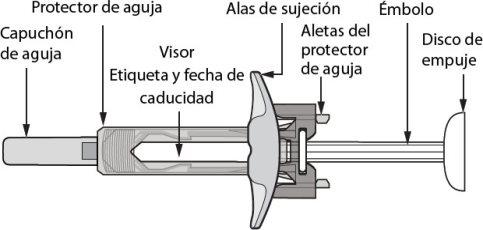
Фігура А:попередньо наповнений шприц-картридж Хірімозу з захисником голки та крилами для фіксації
Важливо: |
|
Зберігання попередньо наповненого шприця-картриджа Хірімозу |
Зберігайте Хірімоз та всі лікарські засоби поза досяжністю дітей. |
Що потрібно для ін'єкції? |
Помістіть наступні предмети на чисту та плоскую поверхню. Коробка попередньо наповненого шприця-картриджа містить:
Коробка попередньо наповненого шприця-картриджа Хірімозу не містить (див. Фігура Б):
Фігура Б:предмети, які не входять до складу коробки |
Перед ін'єкцією | |
|
|
Фігура С:захисник голки не активований; шприц-картридж готовий до використання
| Фігура Д:захисник голки активований; не використовувати
|
Підготовка шприця-картриджа |
Якщо шприц-картридж не пройшов жодного з вищезазначених перевірок, зверніться до вашого фармацевта. |
| |
|
Фігура Е:виберіть місце ін'єкції |
| |
|
Фігура Ф:очистіть місце ін'єкції |
| |
|
Фігура Г:вийміть захисник голки |
|
Фігура Х:вставте голку |
|
Фігура І:тримайте шприц-картридж |
|
Фігура Й:вийміть голку в прямому положенні |
|
Фігура К:повільно звільніть поршень |
| |
|
Фігура Л:утилізація використаного шприця-картриджа |
Якщо у вас є питання, зверніться до лікаря, фармацевта чи медсестри, який знайомий з Хірімозом.
- Країна реєстрації
- Діючі речовини
- Потрібен рецептТак
- Виробник
- Інформація є довідковою і не є медичною порадою. Перед прийомом будь-яких препаратів обов'язково проконсультуйтеся з лікарем. Oladoctor не несе відповідальності за медичні рішення, прийняті на основі цього контенту.
- Альтернативи до ХИРИМОЗ 40 мг РОЗЧИН ДЛЯ ІН'ЄКЦІЙ У ПЕРЕДНАПОВНЕНИХ ШПРИЦАХФорма випуску: РОЗЧИН ДЛЯ ІН'ЄКЦІЙ, 20 мгДіючі речовини: adalimumabВиробник: Amgen Europe B.V.Потрібен рецептФорма випуску: РОЗЧИН ДЛЯ ІН'ЄКЦІЙ, 20 мгДіючі речовини: adalimumabВиробник: Amgen Europe B.V.Потрібен рецептФорма випуску: РОЗЧИН ДЛЯ ІН'ЄКЦІЙ, 40 мгДіючі речовини: adalimumabВиробник: Amgen Europe B.V.Потрібен рецепт
Аналоги ХИРИМОЗ 40 мг РОЗЧИН ДЛЯ ІН'ЄКЦІЙ У ПЕРЕДНАПОВНЕНИХ ШПРИЦАХ в інших країнах
Найкращі аналоги з тією самою діючою речовиною та терапевтичним ефектом.
Аналог ХИРИМОЗ 40 мг РОЗЧИН ДЛЯ ІН'ЄКЦІЙ У ПЕРЕДНАПОВНЕНИХ ШПРИЦАХ у Україна
Лікарі онлайн щодо ХИРИМОЗ 40 мг РОЗЧИН ДЛЯ ІН'ЄКЦІЙ У ПЕРЕДНАПОВНЕНИХ ШПРИЦАХ
Консультація щодо дозування, побічних ефектів, взаємодій, протипоказань та поновлення рецепта на ХИРИМОЗ 40 мг РОЗЧИН ДЛЯ ІН'ЄКЦІЙ У ПЕРЕДНАПОВНЕНИХ ШПРИЦАХ – за рішенням лікаря та згідно з місцевими правилами.







